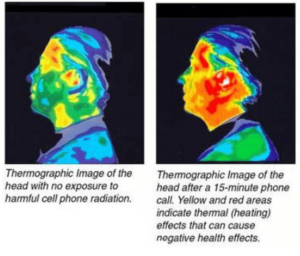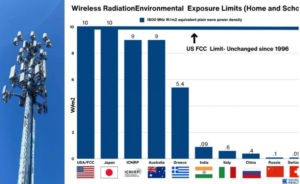Everywhere we turn, wireless devices are shaping our world: smartphones, Wi-Fi routers, 5G towers, and the relentless efforts to make all household appliances into smart home gadgets. But as our reliance on these technologies grows, so do concerns about their safety. The Federal Communications Commission (FCC) sets the guidelines for electromagnetic radiation (EMR) exposure limits in the United States. These limits are supposed to protect public health – but are they actually? Evidence suggests they may be based on outdated science and flawed assumptions, leaving the public exposed to potential risks as the sources of exposure in our day-to-day lives continue to grow.
This article will examine five critical fallacies underlying the FCC’s exposure limits and explore what steps individuals can take to protect themselves in a world increasingly saturated with electromagnetic radiation.
Flawed Assumption #1: Only Heating Effects Matter
The FCC’s exposure limits are rooted in the assumption that EMR only harms biological tissue when it causes significant heating. This stems from decades-old research focusing on thermal effects – the idea that radiation must heat tissues to dangerous levels to cause harm.
The Reality
Heating is not the only issue. Numerous studies have shown that non-thermal biological effects occur at much lower radiation levels. These effects include oxidative stress, DNA damage, and changes in cell signaling, which have been linked to conditions such as headaches, impaired cognitive function, infertility, and even cancer. For instance, the World Health Organization (WHO) classified radiofrequency radiation as a Group 2B (possible) human carcinogen in 2011 due to growing evidence of its health risks.
By focusing solely on heating effects, the FCC’s standards fail to account for the full range of potential biological impacts.
Flawed Assumption #2: Long-Term Effects Are Irrelevant
Another serious flaw in the FCC’s guidelines is the assumption that only acute, short-term effects are relevant. This narrow focus ignores the possibility that long-term, low-level exposure to EMR could have cumulative health effects.
The Reality
Many health conditions linked to EMR exposure, such as hormonal imbalances, infertility, and brain tumors develop over years or even decades. Studies have shown a correlation between long-term exposure to radiofrequency radiation and an increased risk of cancer. For example, research on heavy cell phone users has found the potential for increased risks for certain types of brain tumors.
The FCC’s exposure limits, established decades ago, did not consider these long-term risks, leaving the public vulnerable to potential health consequences from prolonged exposure.
Flawed Assumption #3: Averaging Exposures Is Sufficient
The FCC’s guidelines rely on averaging radiation exposure over time to determine safety thresholds. For example, public exposure is averaged over 30 minutes, while occupational exposure is averaged over six minutes. This approach assumes that short bursts of high-intensity radiation are less significant if diluted over time.
The Reality
Peak radiation bursts – which occur in milliseconds – can have significant biological impacts at the cellular level. Many scientists believe that the erratic nature of wireless signals, characterized by sudden peaks, may be a key factor in their harmful effects. Averaging these peaks dilutes their severity and fails to represent the actual exposure individuals experience.
To illustrate the flaw in this approach, consider this analogy: If someone punches you and breaks your nose, averaging the force of that punch over a year would make it seem insignificant. But in reality, the immediate impact was severe. Similarly, by averaging exposure over time, the FCC’s guidelines downplay the potential harm of peak radiation levels.
Flawed Assumption #4: One Size Fits All
The FCC’s compliance testing uses a standardized model based on a 220-pound adult male head to determine safe exposure levels. This approach assumes that radiation affects everyone uniformly, regardless of age, size, or biological differences.
The Reality
Children, fetuses, and women are more vulnerable to EMR exposure than adult men. Research shows that radiation penetrates deeper into smaller bodies and brains, and children’s developing tissues are more susceptible to damage. Additionally, women and fetuses can absorb higher levels of radiation due to differences in tissue composition.
The current guidelines fail to account for these differences, leaving our more vulnerable populations at greater risk.

Flawed Assumption #5: Uniform Absorption Across Tissues
The FCC assumes that all body tissues absorb radiation uniformly, with no consideration of the unique electrical properties of different tissues.
The Reality
Different tissues absorb radiation at varying rates. For example, female breast tissue, testes, and eyes are particularly vulnerable due to their composition and water content. Children’s tissues, which tend to have higher water content, are also more absorptive. These variations mean that radiation exposure can have localized effects that the FCC’s one-size-fits-all guidelines overlook.
What We Can Take from This
Understanding the flaws in the FCC’s exposure limits is a critical step toward protecting ourselves from the potential risks of EMR. Here are some practical takeaways:
Awareness is Key
Recognizing the limitations of current standards can empower individuals to make more informed choices about their exposure. Small changes, such as reducing screen time, keeping devices at a distance, and using airplane mode, can significantly lower your exposure.
Emerging Solutions: Aires Tech
For those seeking more advanced protection, innovative technologies like Aires Tech offer a proactive approach to mitigating EMR risks. Aires Tech’s solutions are designed to diffract electromagnetic fields, reducing the potential for harmful biological impacts. Their products are particularly valuable for individuals surrounded by wireless devices at work or home, providing an additional layer of safety.

Advocacy for Better Standards
As technology evolves, so should safety regulations. Public advocacy for updated, science-based guidelines is essential to ensure that exposure limits reflect modern research and consider all vulnerable populations.
In Conclusion
The FCC’s electromagnetic radiation exposure limits, while intended to protect public health, are based on flawed and outdated assumptions that fail to address the complexities of modern EMR exposure. From overlooking non-thermal effects and long-term risks to ignoring vulnerable populations and tissue-specific absorption, these guidelines leave significant gaps in safety.
complexities of modern EMR exposure. From overlooking non-thermal effects and long-term risks to ignoring vulnerable populations and tissue-specific absorption, these guidelines leave significant gaps in safety.
As individuals, we can take steps to reduce our exposure and support innovative solutions like Aires Tech. At the same time, we must advocate for updated regulations that reflect the realities of today’s wireless world. By staying informed and proactive, we can better protect ourselves and future generations from the potential risks of electromagnetic radiation.
For more information on EMR safety and Aires Tech’s solutions, visit Aires Tech’s website








